Body Baroque
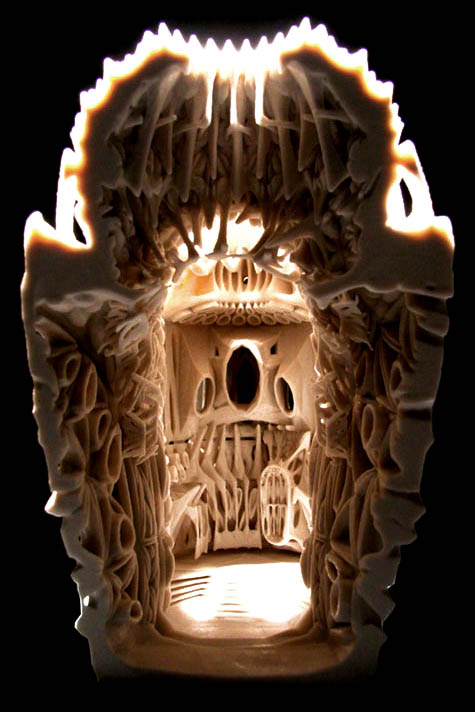 [Image: Yousef Al-Mehdari].
[Image: Yousef Al-Mehdari].A few weeks ago I mentioned some 3D-printed work by Yousef Al-Mehdari, a student at the Bartlett School of Architecture. That work is now pictured here, in a proposal for a site on the island republic of Malta.
 [Image: Malta, just south of Sicily, in the exact center of the image].
[Image: Malta, just south of Sicily, in the exact center of the image].The project explores religious ritual and the human body, alongside an interest in "transitory sculptures," processional routes, and a kind of body-futurist rediscovery of architectural ornament. Vortices of limbs ossify into cathedrals; overlapping anatomies become windows and valves.
Al-Mehdari suggests that a careful – even mathematically exact – study of human bodily movement could serve as a basis for generating new types of architectural form. As if we could take conic sections through Merce Cunningham, say, and turn the resulting diagrams into churches.

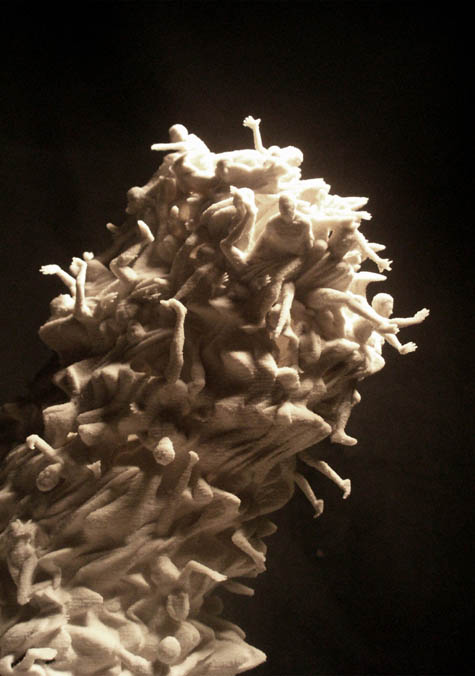 [Images: Yousef Al-Mehdari].
[Images: Yousef Al-Mehdari].It's the Visible Human Project as building typology: Vesalius meets Vitruvius in an era of computed tomography and RHINO.
 [Images: The Visible Human Project].
[Images: The Visible Human Project].The use of the human body as a generator for architectural ornament reminds me, in an admittedly tangential way, of the "cadaver cathedral" by Jeff VanderMeer – the description of which is worth quoting in full:
- Where the sculptures of saints would have been set into the walls, there were instead bodies laid into clear capsules, the white, white skin glistening in the light – row upon row of bodies in the walls, the proliferation of walls. The columns, which rose and arched in bunches of five or six together, were not true columns, but instead highways for blood and other substances: giant red, green, blue, and clear tubes that coursed through the cathedral like arteries. Above, shot through with track lighting from behind, what at first resembled stained-glass windows showing some abstract scene were revealed as clear glass within which organs had been stored: yellow livers, red hearts, pale arms, white eyeballs, rosaries of nerves disembodied from their host.
 [Images: Yousef Al-Mehdari].
[Images: Yousef Al-Mehdari].This further implies, however, that this project might be materially realizable in stone. The ongoing and obvious, but nonetheless absurdly under-discussed problem with today's architectural interest in NURBs, algorithms, Voronoi tiling, parametric rhizo-phylo-archi-bio-futuro-spatiality and so on is that, yes, we can render vast and sprawling webs that consume whole cities, crawling across roofs and down streets through well-drawn tendons, arches, and amorphous sci-fi musculatures – but if all of it then gets built out of pink metal or red auto-painted aluminum that lasts for less than ten months in the wind, rain, and sun, then no matter how much your renderings might look like Tomorrowland, within weeks everything you've built will be indistinguishable from photo-degraded ruins of the early 1970s.
That is, no one is talking about weathering. And it's not a trivial exercise, I would suggest, to imagine, for instance, Zaha Hadid's collected built works re-realized in sandstone: not because this is an earnest material suggestion for Hadid, but because, as a thought-exercise, such alternatives might help architects to realize that their designs could be better served by the use of other materials.
All of which is a long way of saying that, to construct a new church of anatomical horror and to do so out of stone, as Al-Mehdari seems to be suggesting, is a fascinating idea.
And it's a spatial idea that he explores through multiple incarnations of the resulting structure; Al-Mehdari's obvious facility with a 3D printer makes these illustrations of the idea quite exciting.
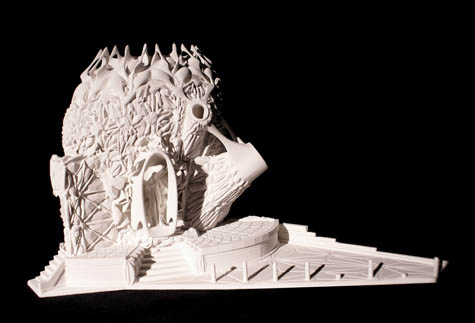
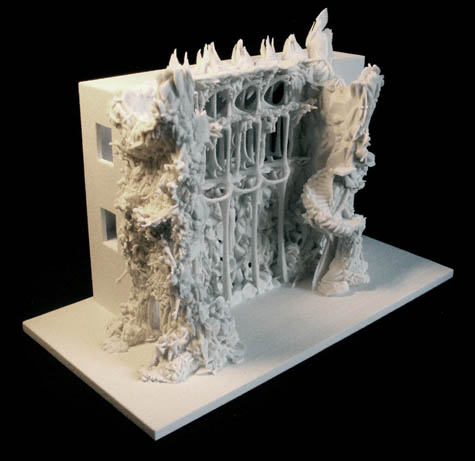
 [Images: Yousef Al-Mehdari].
[Images: Yousef Al-Mehdari].It's also a seriously interesting question: could we hook up milling machines to the existing interiors of cathedrals all over the world and reshape them, in situ, without adding a thing – simply installing new insides through abrasion?
Geometrically unprecedented statuary emerges from the vaults of Chartres. Westminster Abbey is reduced through bandsaws to a superterranean catacomb of interlaced saints.
The following minor structural unit, meanwhile, seems more like a prized fossil found in the mountains of western China than an architectural building-block for a Mediterranean religious site.
 [Image: Yousef Al-Mehdari].
[Image: Yousef Al-Mehdari].And the final two images here are more like nautiloids taken from the abyssal plains – bio-spatial artifacts with benthic resonance, we might say, like something Philip Beesley might use if he was hired to design an artificial reef.
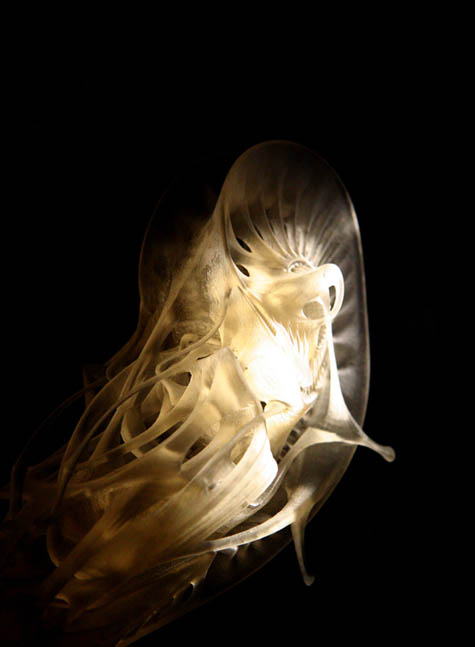
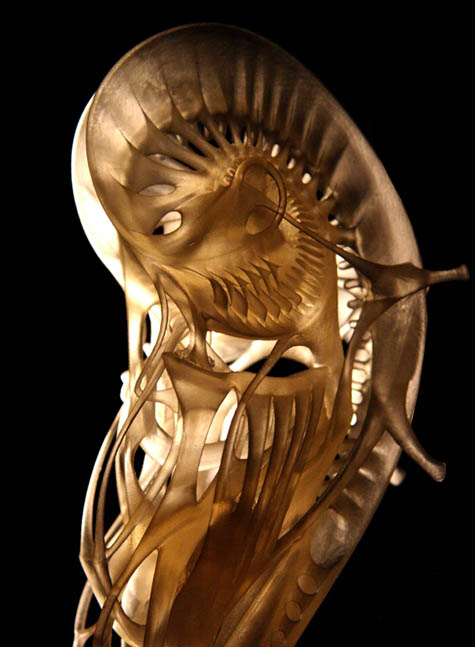 [Images: Yousef Al-Mehdari; it's Jacques Cousteau with a 3D printer, by way of Leviathan and Mike Mignola].
[Images: Yousef Al-Mehdari; it's Jacques Cousteau with a 3D printer, by way of Leviathan and Mike Mignola].Al-Mehdari's models and diagrams are more interesting than my own speculations, however. They will also be on display next month in London, alongside work by another student from the Bartlett, Yaojen Chuang; that exhibition kicks off on October 5th at the dreamspace gallery.





Comments are moderated.
If it's not spam, it will appear here shortly!
interesting Gaudi-like forms! but i think the spaces will functionality in daily use. i love the pureness, it looks like he worked out his concept without doing a single concession.
Hieronymus Bosch in modelling clay? It's like the pillar of skulls in there.
like how the thing has a distinct Lovecraftian geometry woven into it.
I really liked Maltese Stone Age temples - they were a product of a vastly different culture. By walking around one could only imagine the effor and symbolism woven into it. The threshold to one of the temples had a distinct crystal vein in it -- probably the rarest of stones they could find at the time. Some holes on the other threshold, perhaps for the offerings; a stone with a U shaped top -- it was perfect for sitting, but perhaps this would have been a sacriliege at the time.
What I mean is that nothing there was random, everything in those temples had some cryptic reason to their existence. Like a shell of a dead sea animal -- all the flesh has rotted away -- we can only guess what was inside by examining the empty shell.
The lovecraftian church in the article seems to be a set of random empties to be filled with purpose. You could attach any symbolism, ritual or purpose to these organic forms.
If ancient Maltese could build a temple around the rituals and beliefs -- perhaps these buildings could build rituals and beliefs around themselves.
Along Justin's lines, it seems like the interior would be a perfect shrine/temple to for some hellish cult.
Or along the lines of a previous post on this blog about lairs of villains in games, it would be refreshing and truly horrifying experience to virtually inhabit these sorts of spaces. Perhaps the walls could actually 'breathe' and work against the player, as he/she maneuvers through claustrophobic corridors,where the repetition of the elements distorts perceptions of distance.
If he keeps up this line of creating such mind boggling stuff I'm sure if he went into the Special Effects and Design for Film he'd end up being a household name like Giger!
There's actually one Mediterranean cathedral that underwent a partial reshaping of its interior: http://www.lifeinthefastlane.ca/artist-gone-wild-miquel-barcelo/art
with the first image, it immediately came to my mind jan svankmajer's film "the ossuary".
Have a look at it
http://video.google.com/videoplay?docid=-5464393920769221032#
cheers bldgblog!
this reminds me of a Clive Barker short story"in the hills,the cities" im not sure if thats the exact title but it was in the "books of blood"series.
this is an amazing site-I forget how i found it,Im not an architect or student but always find something fasinating.
One day i will get enough time to go through all the archives and links
keep up the great work
thanks jim
wow. its amazing how much it looks like tobias klein's work from the bartlett a few years earlier.
http://www.horhizon.com/works/synthetic-syncretism/
I can see the similarity. It seems tobias started a really popular trend in unit 20.I must admit that very few managed to keep up the good work. Yousef's nautiloid thing is fantastic... very lovecraft!
See TOBIAS KLEIN RIBA silver medalist some years ealier. also of Bartlett.
As mentioned, there's a big dose of Giger in there! and also a bit of David Cronenberg too. I like it.
well, is it coincidence that the idea and design language is from someone who had the facade as a diploma in the same unit at the bartlett and the scans as master, also at the bartlett. i mean indeed its a nice project, but at least, if it is meant serios research you have to mention the sources - "tobias klein". the quality of models and your skills are great - but two years to late. good luck for the future
It is a piece of impudence to copy the work of Tobias Klein so blatantly! Not only did Yousef Al-Mehdari copy Tobias Klein’s diploma and master but also the theory is imitated.
I think it’s outrageous that he presents himself as the originator of Tobias Klein’s ideas and design style.
Of course, Tobias was an inspiration, just as much as Kenny Tsui and Masaki Kakizoe. Their work started a whole new trend in digital architecture. But just like any trend or style in design, people will tend to re-interpret and imitate it in order to better understand it. That’s what has been done with these projects.
These are very disturbing but ultimately amazing. I have seen baroque architecture but never in my dream s would i have thought to add body to it.. and defiantly not in this sense All of these give a skeletal feel something you would almost see out of a horror film. Or the wax museum just with skeletons. I have also seen some current pottery done in this style and am constantly reminded of it.
Reminds me of the organic gun in eXistenZ! Maybe you should try your hand at human weaponry!
Remarkable if not too practical looking!
Post a Comment